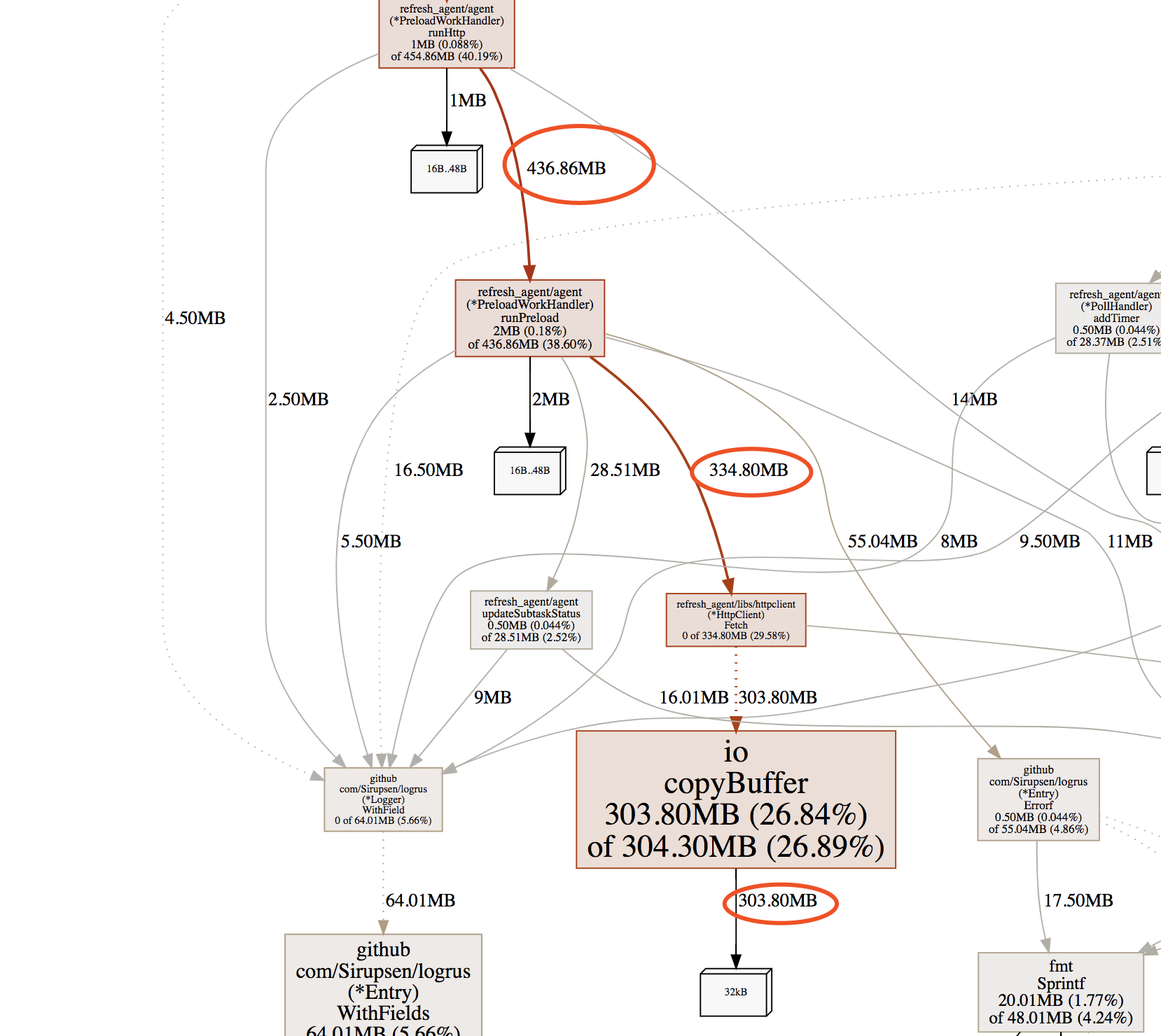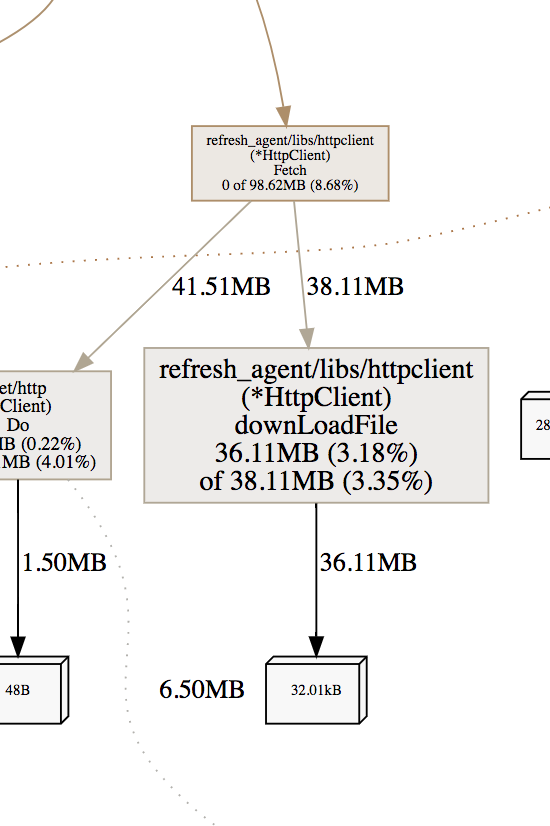一个即将上线的go 写的高频服务,压测的时候发现 gc 特别高,高到10%-15% 左右了,本文记录下优化 gc 的过程和和思路。线上环境1.10.
该文章后续仍在不断的更新修改中, 请移步到原文地址http://dmwan.cc
首先,查看gc 是否有异常,我们可以使用 gctrace 跟踪实时的gc 。执行下面命令可以看到gc 的实时信息。
GODEBUG=gctrace=1 go run cmd/agent_bin.go输出结果如下:
gc 45 @37.801s 11%: 0.19+627+0.29 ms clock, 0.38+424/621/0+0.59 ms cpu, 356->415->225 MB, 453 MB goal, 4 P
gc 46 @39.126s 11%: 2.9+927+0.16 ms clock, 5.8+342/925/0+0.33 ms cpu, 361->460->275 MB, 450 MB goal, 4 P
gc 47 @40.847s 12%: 0.24+1096+0.12 ms clock, 0.49+291/1007/0+0.24 ms cpu, 427->559->319 MB, 551 MB goal, 4 P
gc 48 @42.771s 12%: 0.26+841+0.12 ms clock, 0.52+377/830/0+0.24 ms cpu, 486->561->271 MB, 638 MB goal, 4 P
gc 49 @44.429s 12%: 3.1+890+0.40 ms clock, 6.2+492/833/0+0.81 ms cpu, 440->528->294 MB, 543 MB goal, 4 P
gc 50 @46.188s 12%: 0.23+1165+0.13 ms clock, 0.47+624/1158/0+0.27 ms cpu, 471->579->323 MB, 589 MB goal, 4 P
gc 51 @48.252s 13%: 0.26+1410+0.14 ms clock, 0.52+358/1336/9.9+0.28 ms cpu, 506->620->343 MB, 646 MB goal, 4 P
gc 52 @50.942s 13%: 0.27+806+0.51 ms clock, 0.55+403/805/200+1.0 ms cpu, 549->657->340 MB, 687 MB goal, 4 P
gc 53 @53.014s 13%: 0.10+857+0.36 ms clock, 0.21+467/851/94+0.73 ms cpu, 546->666->351 MB, 681 MB goal, 4 Pgc 45:表示第45次GC,共有4个P (线程)参与GC。
11%: 表示gc 占时间比。
0.19+627+0.29 us:STW(stop-the-world)0.19ms, 并发标记和扫描的时间627ms, STW标记的时间0.29ms。
0.38+424/621/0+0.59 ms cpu, 表示垃圾回收占用cpu时间
356->415->225 MB, 453 MB goal,表示堆的大小,gc后堆的大小,存活堆的大小
453 MB goal 表示整体堆的大小为435M。
根据官方描述,golang1.0 的gc 可以降到100ms 以内,但是这里gc 都超过1s了,这明显是不可以接受的,说明gc 是有很大异常的。
检查思路,首先利用pprof 打出整个调用过程累计的堆分配图,查出到底是哪些模块堆分配异常。通过代码内嵌pprof 暴露端口的方式,终端输出svg。
import _ "net/http/pprof"
go func() {
http.ListenAndServe("0.0.0.0:8080", nil)
}()然后终端输入:
go tool pprof -alloc_space -cum -svg http://127.0.0.1:8080/debug/pprof/heap > heap.svg然后浏览器打开svg,找到消耗最大的调用栈:

使用-cum,是累计函数调用栈的堆分配大小,因为图形会将调用栈很大的路线着重标识出来,这里可以明显看出是自己实现的Fetch 函数的io copyBuffer 函数gc 压力最大。这里大致知道来源了,那到底是我们函数哪个对象有问题?
接下来我们对这个文件使用逃逸分析:直接用go build --gcflags=-m 接文件即可:
我们的源码是这样的:
package httpclient
import (
"io"
"io/ioutil"
"net/http"
"net/url"
"os"
"sync"
"time"
"refresh_agent/utils"
)
var client *http.Client
var buffPool sync.Pool
func init() {
client = &http.Client{}
http.DefaultTransport.(*http.Transport).MaxIdleConnsPerHost = 2000
http.DefaultTransport.(*http.Transport).MaxIdleConns = 20000
}
type HttpClient struct{}
func NewHttpClient() *HttpClient {
httpClient := HttpClient{}
return &httpClient
}
func (this *HttpClient) replaceUrl(srcUrl string, ip string) string {
httpPrefix := "http://"
parsedUrl, err := url.Parse(srcUrl)
if err != nil {
return ""
}
return httpPrefix + ip + parsedUrl.Path
}
func (this *HttpClient) downLoadFile(resp *http.Response) error {
out, err := os.OpenFile("/dev/null", os.O_RDWR|os.O_CREATE|os.O_APPEND, 0666)
defer out.Close()
_, err = io.Copy(out, resp.Body)
return err
}
func (this *HttpClient) Fetch(dstUrl string, method string, proxyHost string, header map[string]string, preload bool, timeout int64) (*http.Response, error) {
// proxyHost 换掉 url 中请求
newUrl := this.replaceUrl(dstUrl, proxyHost)
req, _ := http.NewRequest(method, newUrl, nil)
for k, v := range header {
req.Header.Add(k, v)
}
req.Host = utils.GetUrlHost(dstUrl)
client.Timeout = time.Duration(timeout) * time.Second
resp, err := client.Do(req)
if resp == nil || err != nil {
return resp, err
}
if preload {
err := this.downLoadFile(resp)
if err != nil {
return nil, err
}
}
io.Copy(ioutil.Discard, resp.Body)
resp.Body.Close()
return resp, nil
}逃逸分析的结果如下:
go build --gcflags=-m libs/httpclient/httpclient.go
# refresh_agent/vendor/github.com/garyburd/redigo/redis
gc 1 @0.078s 5%: 0.075+24+0.040 ms clock, 0.15+0.15/11/17+0.081 ms cpu, 16->16->11 MB, 42 MB goal, 2 P
# refresh_agent/vendor/github.com/imroc/req
gc 1 @0.071s 3%: 0.017+26+0.050 ms clock, 0.034+0.22/6.0/22+0.10 ms cpu, 16->17->11 MB, 42 MB goal, 2 P
# refresh_agent/vendor/github.com/BurntSushi/toml
gc 1 @0.054s 6%: 0.086+43+0.062 ms clock, 0.17+0.14/12/14+0.12 ms cpu, 16->17->12 MB, 42 MB goal, 2 P
# refresh_agent/vendor/github.com/modern-go/reflect2
gc 1 @0.054s 7%: 0.070+28+0.051 ms clock, 0.14+0.15/12/14+0.10 ms cpu, 16->17->10 MB, 42 MB goal, 2 P
gc 2 @0.334s 3%: 0.016+33+0.055 ms clock, 0.032+0.54/12/20+0.11 ms cpu, 37->38->14 MB, 54 MB goal, 2 P
# refresh_agent/vendor/github.com/json-iterator/go
gc 1 @0.045s 5%: 0.068+27+0.040 ms clock, 0.13+2.5/4.7/16+0.081 ms cpu, 16->16->11 MB, 42 MB goal, 2 P
gc 2 @0.211s 9%: 0.029+107+0.12 ms clock, 0.058+0.96/52/0+0.24 ms cpu, 39->44->26 MB, 58 MB goal, 2 P
# command-line-arguments
libs/httpclient/httpclient.go:18:6: can inline init.0
libs/httpclient/httpclient.go:26:6: can inline NewHttpClient
libs/httpclient/httpclient.go:19:24: &http.Client literal escapes to heap
libs/httpclient/httpclient.go:28:9: &httpClient escapes to heap
libs/httpclient/httpclient.go:27:2: moved to heap: httpClient
libs/httpclient/httpclient.go:31:62: leaking param: srcUrl
libs/httpclient/httpclient.go:37:25: httpPrefix + ip + parsedUrl.Path escapes to heap
libs/httpclient/httpclient.go:31:62: (*HttpClient).replaceUrl this does not escape
libs/httpclient/httpclient.go:31:62: (*HttpClient).replaceUrl ip does not escape
libs/httpclient/httpclient.go:44:18: out escapes to heap
libs/httpclient/httpclient.go:44:28: resp.Body escapes to heap
libs/httpclient/httpclient.go:41:59: leaking param content: resp
libs/httpclient/httpclient.go:41:59: (*HttpClient).downLoadFile this does not escape
libs/httpclient/httpclient.go:48:151: leaking param: dstUrl
libs/httpclient/httpclient.go:48:151: leaking param: method
libs/httpclient/httpclient.go:48:151: leaking param content: header
libs/httpclient/httpclient.go:69:30: resp.Body escapes to heap
libs/httpclient/httpclient.go:48:151: (*HttpClient).Fetch this does not escape
libs/httpclient/httpclient.go:48:151: (*HttpClient).Fetch proxyHost does not escape
<autogenerated>:1:0: leaking param: .anon0
<autogenerated>:1:0: leaking param: .this
<autogenerated>:1:0: leaking param: io.p
<autogenerated>:1:0: leaking param: .this
<autogenerated>:1:0: os.(*File).close .this does not escape
<autogenerated>:1:0: leaking param: .this
<autogenerated>:1:0: leaking param: .this
<autogenerated>:1:0: leaking param: .this
<autogenerated>:1:0: leaking param: context.key
<autogenerated>:1:0: leaking param: .this这里我们发现resp.Body 逃逸到了堆上。和我们原始的希望是不一致的,我们的目的,是希望将resp.body 重定向到空设备中去,这里的对象最好是分配到栈区。这里看不出,到底哪一步反复创建对象了。
继续追io.CopyBuffer,查看io.Copy 的源码:
func Copy(dst Writer, src Reader) (written int64, err error) {
return copyBuffer(dst, src, nil)
}
// CopyBuffer is identical to Copy except that it stages through the
// provided buffer (if one is required) rather than allocating a
// temporary one. If buf is nil, one is allocated; otherwise if it has
// zero length, CopyBuffer panics.
func CopyBuffer(dst Writer, src Reader, buf []byte) (written int64, err error) {
if buf != nil && len(buf) == 0 {
panic("empty buffer in io.CopyBuffer")
}
return copyBuffer(dst, src, buf)
}
func copyBuffer(dst Writer, src Reader, buf []byte) (written int64, err error) {
// If the reader has a WriteTo method, use it to do the copy.
// Avoids an allocation and a copy.
if wt, ok := src.(WriterTo); ok {
return wt.WriteTo(dst)
}
// Similarly, if the writer has a ReadFrom method, use it to do the copy.
if rt, ok := dst.(ReaderFrom); ok {
return rt.ReadFrom(src)
}
size := 32 * 1024
if l, ok := src.(*LimitedReader); ok && int64(size) > l.N {
if l.N < 1 {
size = 1
} else {
size = int(l.N)
}
}
if buf == nil {
buf = make([]byte, size) #这里反复创建 大小为32k的slice
}看到调用栈提示的函数,发现,我们调用copy 的时候,如果不传入buffer, 内部会反复创建这个buf。基本就定位到问题了。
那么我们知道某个对象会一直被gc 回收,怎么处理呢,通用做法是,使用对象池。
经过改造,我们copy 的时候传一个buffer 进去,这个buffer 从sync.Pool 中去取:
var buffPool sync.Pool
func (this *HttpClient) downLoadFile(resp *http.Response) error {
//err write /dev/null: bad file descriptor#
out, err := os.OpenFile("/dev/null", os.O_RDWR|os.O_CREATE|os.O_APPEND, 0666)
defer out.Close()
buf := buffPool.Get()
if buf == nil {
buf = make([]byte, 32*1024)
}
io.CopyBuffer(out, resp.Body, buf.([]byte))
buffPool.Put(buf)
return err使用这种方式后,这里的堆占用大小立马降下来了:

通过这样的思路,将堆累计分配比较频繁的一些点全部找出来后,gc降到了100ms 以下。
记录几个gc 优化的点, 高频请求一定要注意:
1,函数尽量不要返回map, slice对象, 这种频繁调用的函数会给gc 带来压力。
2,小对象要合并。
3,函数频繁创建的简单的对象,直接返回对象,效果比返回指针效果要好。
4,避不开,能用sync.Pool 就用,虽然有人说1.10 后不推荐使用sync.Pool,但是压测来看,确实还是用效果,堆累计分配大小能减少一半以上。
5,类型转换要注意,官方用法消耗特别大,推荐使用雨痕的方式。
6,避免反复创建slice。
来源:https://my.oschina.net/u/2950272/blog/1788299